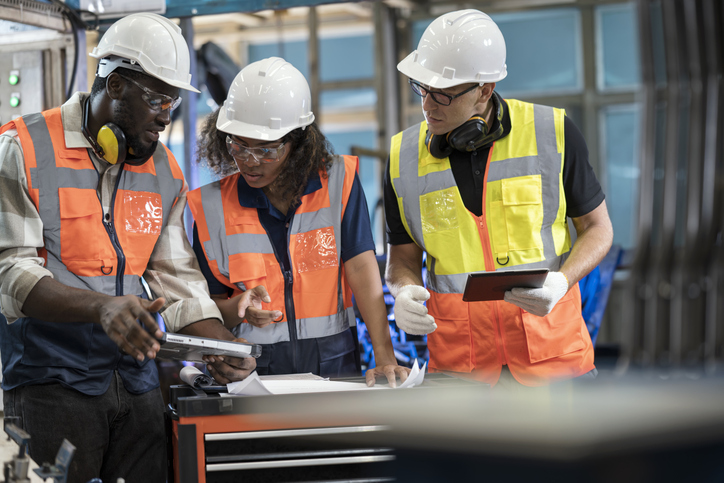Europe’s industrial revival is transforming how and where Europeans work, from smart factories and renewable energy sites to advanced manufacturing lines. But experts warn that without stronger enforcement and updated safety frameworks, the EU’s competitiveness could come at the cost of its workforce.
“Occupational safety and health remains a baseline without which there can be no true positive development for any sector in Europe,” said Bogdan Deleanu from the European Agency for Safety and Health at Work (EU-OSHA), adding, “Re-industrialisation can only work in line with re-professionalising safety.”
As Europe rebuilds its industrial base, the challenge is clear: innovation in worker protection technologies is accelerating, from AI-powered helmets to smart personal protective equipment (PPE), yet regulatory and structural gaps prevent these advances from translating into real safety on the ground.
New risks, new mindset
Today’s industrial revival brings more complex and demanding work. As Deleanu explained, “The risk mix is changing, with new emerging threats, hotter working environments, welding fumes, remote maintenance for green energy production, working with AI, alongside cobots, that have to be managed.”
That means embedding protection into every stage of reindustrialisation, from how risks are assessed and workers trained, to how subcontracting chains and new technologies are regulated.
From offshore wind farms to automated production lines, new production models expose workers to physical, chemical and digital risks that demand smarter responses, not weaker standards.
Personal protective equipment (PPE) has become a prime testing ground for this transformation. “For thirty years I’ve seen PPE evolve from heavy, single-purpose gear into something smarter, lighter and more inclusive,” said Henk Vanhoutte, Secretary-General of the European Safety Federation (ESF).
“We see the introduction of smart PPE, equipment that monitors the environment or the user’s condition,” Vanhoutte explained. “In firefighting, localisation systems can trace where someone is on-site in case of danger. Drones and AI systems can check automatically whether a worker is using the right equipment.”
Lightweight respirators cut exposure to silica dust and asbestos, still major risks in construction and renovation. AI-powered helmets detect unsafe proximity to machinery, reducing incidents by up to 85%, according to the World Economic Forum. Exoskeletons, used in industrial assembly and welding, prevent repetitive strain injuries, while multi-risk fabrics protect against heat, static, and chemicals.
But while technology is advancing, enforcement is lagging. “It’s not that the technology doesn’t exist; it’s that it’s not used or enforced equally,” Vanhoutte warned.
Europe’s safety paradox
Despite these innovations, many worksites across Europe still struggle with the basics, ensuring that workers have and use the right protective gear. Experts point to two persistent problems: inconsistent use of personal protective equipment (PPE) and the continued circulation of non-compliant or counterfeit products.
Both issues stem from the same structural weakness: fragmented enforcement and blurred responsibility along subcontracting chains.
“Subcontracting and labour-market intermediation have become a business model that fosters abuse and insecurity,” said Esther Lynch, Secretary General of the European Trade Union Confederation (ETUC) at a recent European Parliament event, No more exploitation: regulating subcontracting and labour intermediation in Europe. “We can’t allow that to grow and succeed.”
Her warning reflects a reality visible across sectors: the deeper the subcontracting chain, the weaker the protection. “We see a lot of legislation around safety and health,” said Tom Deleu, General Secretary of the European Federation of Construction and Woodworkers (EFBWW). “The problem is the application. Especially when there are long chains of subcontracting, the deeper you go, the less protection and training workers have.”
Unsafe products on the market
The same inconsistency undermines Europe’s internal market for protective gear. “Market surveillance on PPE products is still far too limited,” warned Henk Vanhoutte. “We see a lot of non-compliant imports entering the European market, especially through online sales. There’s too little control.”
He pointed to wide variations between Member States. “For respiratory protection, there are countries where workers using a mask must do a face-fit test at least once a year. Elsewhere that’s not the case, or not inspected. We’d like to see that explicitly written into the rules.”
For Vanhoutte and other experts, the issue is not a lack of innovation, but the lack of a level playing field: too many unsafe products reach workers, while enforcement lags behind technology.
Competitive advantage in safety
That imbalance is no longer just a question of protection; it’s becoming a question of Europe’s competitiveness. The World Economic Forum calls workplace safety a “strategic advantage” for manufacturers struggling with labour shortages.
Companies investing in safer, human-centric workplaces report fewer disruptions, lower turnover, and higher morale, all key to industrial resilience.
The latest Eurofound survey adds a social dimension: Europeans now rank a safe working environment as the most important factor of job quality, ahead of pay or flexibility.
For Lynch, the message is political as much as economic. “Europe should compete because we’re the best,” she told Euractiv, warning against any attempt to lower health or safety standards in the name of competitiveness.
Towards a new safety deal
The consensus among unions and safety experts is unified: Europe’s industrial transition cannot succeed without a modernised safety framework. What they are calling for amounts to a new safety deal, one that matches Europe’s investment in green and digital industries with equal ambition for worker protection.
And, the priorities are clear: update the EU’s ageing safety framework, limit excessive subcontracting, strengthen inspection and enforcement, and ensure consistent market surveillance for PPE across all Member States.
“True competitiveness depends on a stable, thriving workforce, not one constantly on sick leave due to burnout or accidents,” Deleanu said.
(BM)


